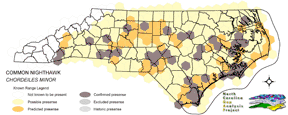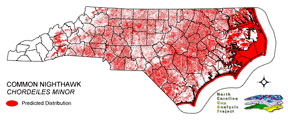
| Taxa: |
| Order: |
| Family: |
| Aves |
| Caprimu.giformes |
| Caprimulgidae |
| NatureServe Global Rank: |
| NatureServe State (NC) Rank: |
| G5 |
| S4B,SZN |
| Federal Status: |
| NC State Status: |
| --- |
| --- |


| Land Unit |
| US Fish & Wildlife Service |
| US Forest Service |
| US National Park Service |
| US Department of Defense |
| NC State Parks |
| NC University System |
| NC Wildlife Res. Com. |
| NC Forest Service |
| NC Div. of Coastal Mgmt. |
| Local Governments |
| Non-Governmental Org. |
| Other Public Lands |
| Private Lands |
| GAP Status 1-2 |
| All Protected Lands |
| Statewide |
| Hectares |
| 25,306.65 |
| 6,193.89 |
| 30,026.88 |
| 12,960.72 |
| 4,844.43 |
| 3,966.93 |
| 11,837.70 |
| 1,970.94 |
| 2,065.32 |
| 1,771.83 |
| 4,209.75 |
| 3,318.21 |
| 4,572,383.58 |
| 51,843.00 |
| 104,856.06 |
| 4,680,856.83 |
| Acres |
| 62,534.08 |
| 15,305.43 |
| 74,198.02 |
| 32,026.63 |
| 11,970.84 |
| 9,802.50 |
| 29,251.59 |
| 5,157.78 |
| 5,103.52 |
| 4,378.29 |
| 10,402.52 |
| 8,199.47 |
| 11,298,603.69 |
| 128,394.30 |
| 259,392.40 |
| 11,566,934.35 |
| % of Dist. on |
| Prot. Lands |
| 24.1 % |
| 5.9 % |
| 26.7 % |
| 12.4 % |
| 4.6 % |
| 3.8 % |
| 10.7 % |
| 1.9 % |
| 2.0 % |
| 3.9 % |
| 3.9 % |
| 2.5 % |
| < 0.1 % |
| 49.4 % |
| ----- |
| ----- |
| % of Dist. on |
| All Lands |
| 0.5 % |
| 0.1 % |
| 0.6 % |
| 0.3 % |
| 0.1 % |
| < 0.1 % |
| 0.3 % |
| < 0.1 % |
| < 0.1 % |
| < 0.1 % |
| < 0.1 % |
| < 0.1 % |
| 97.7 % |
| 1.1 % |
| ----- |
| ----- |
|
Breeds throughout most of the state where suitable habitat exists Fussell 1994, Potter et al. 1980); occasional on the barrier islands (Fussell and Lyons 1990). In the mountain region, found mostly in lowlands and valleys (Simpson 1992). Nests in generally open areas, including: rocky areas, sparsely vegetated or burnt areas in woodlands, on rocky beaches or coral flats, fields, vineyards, gardens (Cleere 1998), clear-cuts, and around towns (Fussell 1994). Eggs are laid on the ground, on leaf litter, pine needles, loose stones, crumbled bricks, burnt ground, sand, rock, or vegetation such as moss or lichens, between rails on active railway tracks (Cleere 1998), on sand dunes, or between rows of crops (Potter et al. 1980). May occasionally use an old nest of the American Robin and often nests on gravel roof tops and fence posts. May breed semi-colonially (Cleere 1998). During the day, birds roost on the ground, in a tree limb, or on a roof (Nicholson 1997). Foraging is usually done high in the sky, but sometimes forages insects attracted to light sources (Cleere 1998). NATURE SERVE GLOBAL HABITAT COMMENTS: ALL SEASONS: In mountains and plains in open and semi-open habitat; in open coniferous forests, savanna, grasslands, fields, around cities and towns. BREEDING: Nests on the ground on a bare site in an open area. In some areas, also nests on flat gravel roofs of buildings, perhaps related to prey availability at artificial lights. Prefers sandy soil in the southern U.S. |
| Code | Name | Description | NC Natural Heritage Program Equivalent |
| 378 | Ocean Beaches | Open beach sand. | Upper Beach |
| 3 | Tidal Marsh | Fresh and brackish tidal marshes, including cord grass, wild rice, sawgrass and needlerush alliances. | Brackish Marsh, Interdune pond, Maritime wet grassland |
| 124 | Maritime Scrubs and Tidal Shrublands | Coastal shrubs including wax-myrtle, swamp rose, alder, yaupon, and greenbriar. | Maritime Shrubs, Salt Shrub |
| 375 | Hypersaline coastal salt flats | Tidal flats within salt marshes, including saltmeadow cordgrass or sea-purslane dominated alliances. | Salt Marsh |
| 371 | Maritime Grasslands | Dune grass community consisting of sea oats and beach grasses. | Dune grass, Maritime dry grassland |
| 173 | Coastal Plain Riverbank Shrubs | Shrub dominated riverbanks, commonly dominated by willows and/or alders. | Sand and Mud Bar |
| 239 | Piedmont/Mountain Emergent Vegetation | Emergent vegetation of all wetland hydrologies. Sites would commonly support species such as tussock sedge, rushs, and cattail alliances. | Rocky Bar and Shore (in part) |
| 267 | Riverbank Shrublands | Riverside shrubs with temporarily flooded hydrologies. Found in the both the Mountains and Piedmont. Containing dominants such as smooth alder and a Carolina or black willows. | Sand and Mud Bar |
| 269 | Floodplain Wet Shrublands | Saturated shrublands of the Piedmont, includes buttonbush, swamp-loosestrife, decodon and alders. | Piedmont/mountain Semipermanent Impoundment |
| 20 | Coniferous Regeneration | Regenerating pine stands. Predominantly loblolly pine, but slash and longleaf stands occur as well. | No equivalent |
| 36 | Successional Deciduous Forests | Regenerating deciduous trees with a shrub stature. Commonly dominated by sweetgum, tulip poplars and maples. | No equivalent |
| 180 | Agricultural Crop Fields | Farm fields used for row crops. | No equivalent |
| 205 | Agricultural Pasture/Hay and Natural Herbaceous | Farm fields used for pasture grass or hay production, as well as old fields dominated by native and exotic grasses. | No equivalent |
| 213 | Barren; quarries, strip mines, and gravel pits | Quarries, strip mines, or gravel pits. | No equivalent |
| 214 | Barren; bare rock and sand | Areas of bare rock, sand or clay. | No equivalent |
| 60 | Sand | Exposed sand, predominantly in the sandhills region where disturbance or the extreme site conditions prevent natural regeneration. | No equivalent |
| 202 | Residential Urban | Includes vegetation interspersed in residential areas. Includes lawns, mixed species woodlots, and horticultural shrubs. Vegetation accounts for between 20 - 70% of the cover. | No equivalent |
| 203 | Urban Low-Intensity Developed | Highly developed areas with vegetation accounting for < 20% of the cover. | No equivalent |
| 204 | Urban High-Intensity Developed and Transportation Corridors | Highly developed areas including infrastructure such as roads, railroads. Vegetation represents < 20% of the cover. | No equivalent |
| 8 | Open water | Open water without aquatic vegetation. | No equivalent |
|
Ehrlich, P.R., D.S. Dobkin, and D. Wheye. 1992. Birds in jeopardy:the imperiled and extinct birds of the United States and Canada, including Hawaii and Puerto Rico. Stanford University Press, Stanford, California. 259 pp.
Simpson MB Jr. 1992. Birds of the Blue Ridge Mountains. Chapel Hill and London: University of North Carolina Press. Fussell, J. III and M. Lyons. 1990. Birds of the Outer Banks [pamphlet]. Eastern National Parks and Monument Association Coastal Wildlife Refuge Society. Fussell, J.O. III. 1994. A birderís guide to coastal North Carolina. Chapel Hill and London: The University of North Carolina Press. Nicholson CP. 1997. Atlas of the breeding birds of Tennessee. Knoxville: University of Tennessee Press. Dickerman, R.W. 1990. Geographic variation in the juvenal plumage of the common nighthawk (CHORDEILES MINOR) in North America. Auk 107:610-613. Stevenson, H. M., et al. 1983. Notes on common and Antillean nighthawks of the Florida Keys. Auk 100:983-988. Harrison, C. 1978. A field guide to the nests, eggs and nestlings of North American birds. Collins, Cleveland, Ohio. Potter, E. F., J. F. Parnell, and R. P. Teulings. 1980. Birds of the Carolinas. Univ. North Carolina Press, Chapel Hill. 408 pp. Terres, J.K. 1980. The Audubon Society encyclopedia of North American birds. Alfred A. Knopf, New York. American Ornithologists' Union (AOU), Committee on Classification and Nomenclature. 1983. Check-list of North American Birds. Sixth Edition. American Ornithologists' Union, Allen Press, Inc., Lawrence, Kansas. Raffaele, H.A. 1983. A guide to the birds of Puerto Rico and the Virgin Islands. Fondo Educativo Interamericano, San Juan, Puerto Rico. 255 pp. Hilty, S.L., and W.L. Brown. 1986. A guide to the birds of Colombia. Princeton University Press, Princeton, New Jersey. 836 pp. Stiles, F.G., and A.F. Skutch. 1989. A guide to the birds of Costa Rica. Comstock Publ. Associates, Cornell University Press, Ithaca, New York. 511 pp. |
For more information please contact them at:
NC-GAP Analysis Project
Dept. of Zoology, NCSU
Campus Box 7617
Raleigh, NC 27695-7617
(919) 513-2853
www.basic.ncsu.edu/ncgap